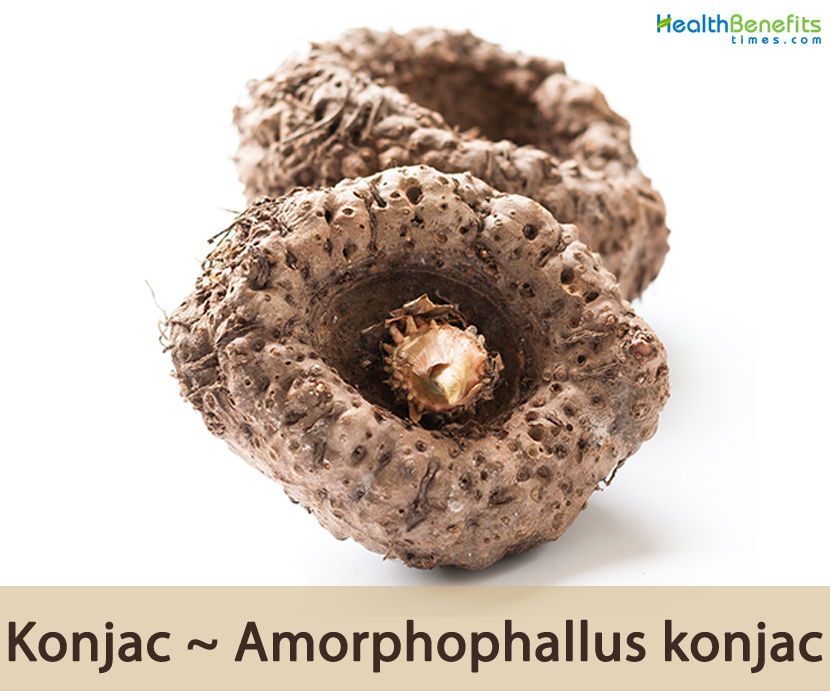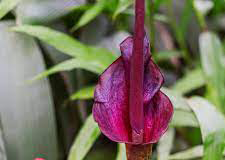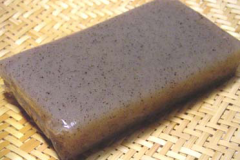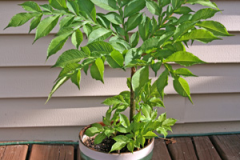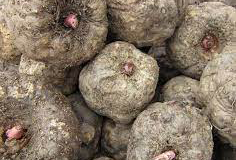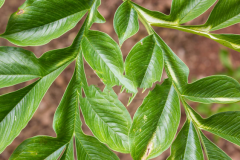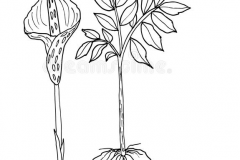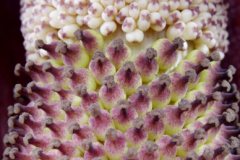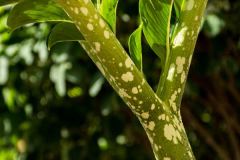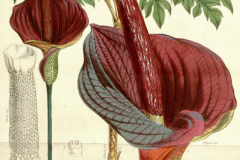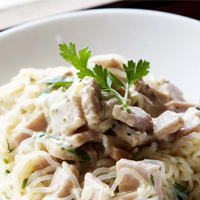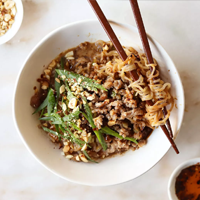The genus name Amorphophallus comes from the Greek amorphos meaning shapeless or deformed and phallus meaning penis. The specific epithet konjac comes from the colloquial name for both the plant as well as the starchy food made from the tubers. Konjac is a root vegetable that grows in parts of Asia. It’s known for its starchy corm, a tuber-like part of the stem that grows underground. The corm is used to make a rich source of soluble dietary fiber known as glucomannan. Starch extracted from the cooked corms is edible and used to make noodles, jellies, fruit candies, vegan seafood, and as a thickening or stabilizing agent in food and drink. The cooked corms also have various traditional medicinal uses. In the Western world, it’s used as a food additive and dietary supplement to lower plasma cholesterol, improve carbohydrate metabolism, and help bowel movements. Recently, you may find it in grocery stores as shirataki noodles.
Konjac Facts
| Konjac Quick Facts | |
|---|---|
| Name: | Konjac |
| Scientific Name: | Amorphophallus konjac |
| Origin | Subtropical to tropical areas of eastern Asia, including Vietnam, Japan, southern and south-eastern China, Indonesia and possibly Laos |
| Health benefits | Support for Constipation, Blood Cholesterol, Skin health, Bone Health, Immune System, metabolism, Cancer, digestion, diabetes, oral health, blood pressure, Eye Health, PMS symptoms and Cardiovascular Diseases |
| Name | Konjac (devil’s-tongue) |
|---|---|
| Scientific Name | Amorphophallus konjac |
| Native | Warm subtropical to tropical areas of eastern Asia, including Vietnam, Japan, southern and south-eastern China, Indonesia and possibly Laos |
| Common Names | Elephant-yam, devil’s-tongue, Konjac, Leopard-palm, Snake-palm, Umbrella arum, Elephant foot, Snake plant, elephant-foot yam, konjac, konnyaku potato, voodoo lily, konjaku |
| Name in Other Languages | Afrikaans: Devil’s-tong Albanian: Devil’s-gjuhë Amharic: Yedīyabīlosi milasi (የዲያቢሎስ ምላስ) Arabic: Lisan alshaytan (لسان الشيطان), kunjak (كونجاك) Armenian: Satanayi lezu (սատանայի լեզու) Azerbaijani: Seytanın dili Bengali: Jihbā (জিহ্বা) Bulgarian: Devil’s ezik Burmese: Marrnaat eat shar (မာရ်နတ်၏လျှာ), w u pain (ဝဥပင်) Chinese: Móguǐ de shétou (魔鬼的舌头), Mo yu (魔芋), jǔruò (蒟蒻), Jyutping, huā mó yù (花蘑芋), Ruò tóu (蒻头), Shā rén ké (砂仁壳), Huā móyù (mó yù)(花蘑芋(魔芋)), Dōng chuān mó yù (东川磨芋) Croatian: Devil’s-jezik Czech: Dábelský jazyk, zmijovec indický Danish: Djævelsbid tungen Dutch: Duivels-tong, Konjak English: Elephant-yam, devil’s-tongue, Konjac, Leopard-palm, Snake-palm, Umbrella arum, Elephant foot, Snake plant, elephant-foot yam, konjac, konnyaku potato, voodoo lily Esperanto: Diablo-lango Estonian: Kuradi keel, Rivière’i titaanjuur Filipino: Wika ng diyablo Finnish: Paholaisen-kieli , Mukulapökkövehka, Konjak French: Langue du diable, konjac Georgian: Eshmak’is ena (ეშმაკის ენა) German: Teufelszunge, Stinkende Titanenwurz, Konjakwurzel, Greek: Glóssa tou diavólou (γλώσσα του διαβόλου) Gujarati: Śētānanī jībha (શેતાનની જીભ) Hausa: Harshen shaidan Hebrew: לשון השטן, קונג’אק Hindi: Devil’s-tongue Hungarian: Devil’s-nyelv, leopárdkontyvirág Icelandic: Djöfulsins tunga Indonesian: Lidah iblis, Konnyaku Irish: Teanga an diabhail Italian: Diavolo-linguetta Japanese: Akuma no shita (悪魔の舌), Konnyaku (こんにゃく) Javanese: Setan-ilat, Konnyaku Kannada: Devvada nālige (ದೆವ್ವದ ನಾಲಿಗೆ) Kazakh: Saytannıñ tili (шайтанның тілі) Korean: Agmaui hyeo (악마의 혀), Gon yak, Gu yak, Gu yak phul (Kuyakphul), gon-yag (곤약) Kurdish: Zimanê şeytan Lao: Lin khong man (ລີ້ນຂອງມານ) Latin: Devil’s lingua Latvian: Velna mēle Lingua Franca Nova: Coniac Lithuanian: Velnio liežuvis, Leopardinis amorfofalas Macedonian: Gavolski jazik (ѓаволски јазик) Malagasy: Devil’s-lela Malay: Devil’s-tongue, Konnyaku Malayalam: Piśācinṟe nāv (പിശാചിന്റെ നാവ്) Maltese: Devil’s-ilsien Marathi: Bhūta cyā jībha (भूत च्या जीभ) Mongolian: Chötgöriin khel (чөтгөрийн хэл) Nepali: Śaitānakō jībha (शैतानको जीभ) Norwegian: Devil’s målet Oriya: ଶୟତାନର ଜିଭ Pashto: د شیطان ژبه Persian: زبان شیطان, کوننیاکو Philippines: Pungapung, bulangan Polish: Diabelski język, Dziwidło Riviera Portuguese: Lingua do diabo, Kon’nyaku Punjabi: Śaitāna dī jībha (ਸ਼ੈਤਾਨ ਦੀ ਜੀਭ) Romanian: Limba-Diavolului, konjak Russian: Amorfofallius kon’iak (аморфофаллус коньяк) Serbian: Davolji jezik (ђавољи језик) Sindhi: شيطان جي ٻولي Sinhala: Yakṣayāgē diva (යක්ෂයාගේ දිව) Slovenian: Hudičev jezik Spanish: Lengua del Diablo, Glucomanano Sundanese: Iblis-lidah Swedish: Devil-tunga, Konjak-knölkalla Tagalog: Bulangan, Pangapung Tajik: Zaʙoni devona (забони девона) Tamil: Picāciṉ nākku (பிசாசின் நாக்கு) Telugu: Devil’s-tongue Thai: Devil’s-tongue, Buk Turkish: Devil’s-dil Ukrainian: Chortovyy yazyk (чортовий язик) Urdu: شیطان کی زبان Uzbek: Iblisning tili Vietnamese: Lưỡi quỷ, Nua trông, củ nưa, khoai nưa, củ huyền Welsh: Tafod diafol Zulu: Ulimi lukaSathane |
| Plant Growth Habit | Herbaceous, corm-producing perennial plant |
| Growing Climates | Open situations, forest margins, open thickets, secondary forests, moist shady habitats and also village groves |
| Soil | Produced on deep, fertile, alluvial soils that are slightly acid and Dislikes heavy clay soils |
| Corm | Globose tuber having a diameter of 30 cm that produces rhizomatous offsets of 50 cm long and 3 cm thick |
| Tuber | Tuber up to 30 cm in diameter and 20 cm long, weighing up to 10(-13) kg |
| Tuber Weight | up to 50 pounds |
| Leaf | Umbrella-shaped with dull pink type petioles of 1 m in length that are marbled dark green and dotted white, with highly dissected blades of 2 m, divided into many leaflets that are 3–10 cm long and 2–6 cm in diameter. Its peduncle is 1.1 m long, colored in the same ways as its petioles |
| Flowering season | May, June, July |
| Flower | Inflorescence a spadix 15–110 cm long, female in lower part, becoming male higher up via a transitional zone, with a well-developed asexual part at the top, spadix partly enveloped by the spathe 10-60 cm × 10-55 cm, spathe limb erect, undulate or folded longitudinally with spreading margins, outside dark purplish-brown with scattered blackish-green spots, inside dark brown, glossy |
| Flavor/Aroma | Strong odor of rotten flesh |
| Plant Parts Used | Roots , Stem Tuber , Corm , Seeds |
| Propagation | By seed |
| Health Benefits |
|
Plant Description
Konjac is an herbaceous, corm-producing perennial plant which has an underground stem in the form of a corm, a globose tuber having a diameter of 30 cm that produces rhizomatous offsets of 50 cm long and 3 cm thick. The konjac plant’s stem grows up to six feet tall. The plant is found growing in open situations, forest margins, open thickets, secondary forests, moist shady habitats and also village groves. It is considered a unique specimen for containers, mixed borders, or greenhouses. The plant produced on deep, fertile, alluvial soils that are slightly acid and dislikes heavy clay soils. This species is cultivated around the world as an ornamental and grown throughout East Asia as a food crop.
Tuber
The plant produces globose tuber having a diameter of 30 cm that produces rhizomatous offsets of 50 cm long and 3 cm thick. The tuber can grow up to 50 pounds. The tuber shrinks away as the new leaf grows and during the growing season a new, larger tuber replaces it. The starchy tubers are edible and this plant is grown for food in some parts of the world, processed into a tasteless flour or stiff jelly (which can be used as a vegan substitute for gelatin). The Japanese use konjac flour to make shirataki noodles, and the starch is used to make a popular Asian fruit jelly snack.
Leaves
The corms will produce a single, highly divided umbrella-shaped leaf with a dull pink type petiole (leaf stem) of 1 m in length that are marbled dark green and dotted white, with highly dissected blades of 2 m, divided into many leaflets that are 3–10 cm long and 2–6 cm in diameter. The petiole can reach 4-5 feet tall and the leaf blade can reach up to 4 feet across. The leaf will turn brown in autumn and then die.
Flower
When the corms reach maturity they will produce an inflorescence before the leaf emerges. Its peduncle is 1.1 m long, colored in the same ways as its petioles. The aroid-type inflorescence is made up of a dense, spike-like spadix which bears numerous, small, male and female flowers and a leafy, dark maroon to purple-brown spathe with ruffled margins. The 3-4 feet tall bloom emits a strong odor of rotten flesh for many days that easily attract flies.
Nutritional Value of Konjac
Konjac consists of lots of Vitamin, Minerals and other components. Among these some of the vitamins that Konjac has Vitamin C, Vitamin A, Folates, Niacin, Pantothenic acid and Choline. Konjac also contains Omega 3 fatty acids, Omega 6 fatty acids, dietary fiber, sodium and potassium, which have lots of health advantages. Apart from this Konjac also contains minerals such as calcium, magnesium, manganese, selenium, phosphorous, iron, protein, zinc and copper. The best part of the Konjac is, it contains zero cholesterol.
Konjac Image Gallery
Health benefits of Konjac
The high fiber content of konjac has many health benefits. Soluble fiber helps lower cholesterol and blood glucose levels. Diet high in fiber may also help regulate bowel movements, prevent hemorrhoids, and help prevent diverticular disease. Listed below are some of the popular health benefits of using Konjac
1. Aids in Constipation
Konjac has suitable properties that may fight constipation and achieve healthy bowel movements. Research found that konjac glucomannan (KGM) relieves constipation. It also decreases the chance of constipation and helps in bowel movements. Research also found that if we add glucomannan supplements to low fiber foods, then it may help defecation. (1), (2)
2. Manages Weight
Konjac is proven to be beneficial for people who are looking forward to lose excess body weight. Fiber when consumed frequently keeps a person full for extended period of time reducing the snacking in between the meals.
Research has concluded that adding glucomannan fiber to a balanced diet helped the participants in reducing body weight. Glucomannan keeps a person full for a longer time period by slowing down the rate at which the digestive system empties. However, the research also found that konjac had no role in promoting weight loss. (3), (4), (5)
3. Reduces Blood Cholesterol
High cholesterol levels in the body are a more significant problem nowadays. It is becoming widespread to have increased cholesterol levels. Konjac helps in reducing cholesterol levels in the body. Research concluded that konjac flour may help in lowering cholesterol levels. Also, it can reduce fasting blood sugar. Researchers have found that konjac flour can be good therapy for diabetic patients. Glucomannan was beneficial for total cholesterol and LDL cholesterol in this study, but not HDL cholesterol or blood pressure. (6)
4. Skin health
Konjac consists of anti-inflammatory and antimicrobial properties, which is very good for our skin and it also helps in healing wound in our skin. Apart from this konjac is highly rich in antioxidant, such as vitamin C, which protect our skin from free radical and prevent them to do any oxidative damage to our skin cells, it is the main cause for various types of skin related issues, such as wrinkles, dark spots, acne, signs of aging, etc. (7), (8)
5. Improve Bone Health
Konjac consists of good amount of calcium, magnesium and phosphorus, all these minerals are very important for our bone structure and health. Consumption of Konjac helps to improve the bone density and keep our bone stronger and healthy. It also helps in repairing and the growth of bone tissues. Apart from this Konjac is highly rich in Vitamin C, which is also very beneficial for our bone health. Vitamin C helps to encourage the absorption of calcium in our body and it also helps to prevent the oxidative damage to our bone tissue and prevent the macular degeneration of bone. Studies have been proven that consumption of calcium rich food, such as konjac can improve our bone health and reduce the risk of various types of bone issues, such as osteoporosis.
6. Boost Immune System
Konjac consists of good amount of Vitamin C which is very beneficial for our immune system and protects our body from several foreign invaders, such as bacteria and virus. Vitamin C helps in the production of white blood cells in our body; it is the main component of our own immune system. Beside this vitamin C is a strong antioxidant, which fights against free radicals and protect our immune system cells from oxidative damage caused by free radicals.
7. Boost metabolism
Glucomannan is a water-soluble fiber which can influence people who have a slow or unbalanced metabolism. By increasing blood flow and energy, the compound boosts metabolic rate. This, in combination with a healthy diet, promotes weight loss and improved digestion.
8. Reduce the Risk of Cancer
As we already discussed konjac is highly rich in vitamin C, it is a strong antioxidant, which fight against free radicals and prevent the oxidative damage to our healthy cells caused by free radicals, and these free radicals are the main cause of cancer.
9. Excels wound recovery
Konjac root is high in mannose carbohydrates, which can hasten wound healing. Glucomannan also has a natural immune-boosting effect. A well-regulated and healthy immune system aids the body’s ability to fight bacteria and recover.
10. Improves digestion
Konjac is water soluble and thus aids digestion. It is able to help strengthen your digestive system, making it a great natural remedy for those who have digestion problems. It can also aid with constipation and hemorrhoids.
11. Helps control diabetes
Konjac consists of glucomannan; this is a great agent to help control sugar levels in the body, thus helping with the control and symptoms of diabetes.
12. Improves oral health
Konjac root consists of anti-bacterial components that benefit both overall health and oral health. This can aid in the reduction or elimination of minor oral health issues such as inflammation, pain, and fight against harmful bacteria.
13. Increased immunity
Because of the konjac plant’s anti-bacterial properties and antioxidants, it is supposed that you may gain an increased immunity. Body may be able to help fight common diseases such as cold and flu more effectively.
14. Control blood pressure
If you have blood pressure issues, you may want to try and include konjac root into your diet. The plant can help to stabilize blood pressure levels, which thus will help with your heart health.
15. Promotes Eye Health
Konjac is highly rich in vitamin C, which is very beneficial for our eye health. Vitamin C is a strong antioxidant, which is fighting against free radicals and prevents oxidative damage to our cells, thus prevent the macular degeneration of eye cells. Studies have been proven that consumption of konjac on a regular basis can reduce the risk of various eye issues, such as cataract.
16. Reduce PMS symptoms
PMS can be quite problematic for many women and girls, but the konjac plant can help by providing added vitamins and minerals to your diet. This can help to overcome some of the symptoms of PMS for women. The root plant is also a natural anti-inflammatory, which helps to reduce swelling and PMS pains during the phase.
17. Increases mineral absorption
Healthy diet is beneficial to the body, but improved mineral absorption can provide even greater benefits. Konjac root improves the body’s ability to absorb minerals naturally. As a result of improved absorption, a person can benefit more from the healthy foods and beverages they consume.
18. Anti-inflammatory
Konjac consists of great amounts of anti-inflammatory agents, which can help with bone and joint health. You might find a way to proper nourish your bones and a decrease in joint pain. This is particularly useful for those suffering from conditions such arthritis.
19. Reduces the Risk of Cardiovascular Diseases
Cardiovascular diseases affect human health. Also, heart health is essential to weight management. Research found that konjac glucomannan (KGM) helps fight cardiovascular problems. This study shows that KGM can help in short-term use. If you take 3 grams of KGM/day, it will reduce the LDL and non-HDL cholesterols by 7% to 10%. Hence health professionals found it to be beneficial in aiding cardiovascular diseases.
Traditional uses and benefits of Konjac (devil’s-tongue)
- Flowers are used as treatment for fever.
- Root is used in facilitating childbirth, as a sialogogue (increases the saliva flow rate), and as treatment for cancer.
- Corm consists of glucomannan which helps in weight loss, relieving constipation and irritable bowel syndrome, and reducing serum cholesterol levels.
- It can give a feeling of fullness and aid in weight loss.
- It relieves constipation and irritable bowel syndrome, as well as reducing serum cholesterol levels.
- Glucomannan is extensively used as an emulsifier and stabilizer in foods and drinks.
- The root is oxytocic and sialagogue.
- It is used in the treatment of cancer.
- Glucomannan, a soluble fiber obtained from the tuber, cannot be metabolized by the human body, but is metabolized by intestinal bacteria.
- The flowers are febrifuge.
- Tuber is recommended as an adjunct in low-calorie diets and to control the blood cholesterol level.
- Tuber is used in traditional medicine in Vietnam as a poultice against furuncles.
- They are applied externally as an irritant to treat acute rheumatism.
-
Tubers are administered internally to treat dysentery and hemorrhoids.
- In the Philippines, the tubers are considered caustic, and are also used as anti-rheumatic poultice.
- In India, the roots are used against ophthalmia, and applied to boils and as an emmenagogue.
- Fermented juice of the petioles is used to cure diarrhea in India and Papua New Guinea.
- The tuber is given in Thailand as a food supplement for diabetic patients.
- Since the roots are acrid, these are used in herbal medicines to treat boils.
- Rich in starch and caustic, konjac is used as an external stimulant.
- Tubers, roots and corms are used to treat hemorrhoids.
- Roots are combined with several other herbs to cure dyspepsia, piles, colic, fistula, skin as well as blood diseases, urinary infections and colic.
- Crushed seeds of konjac are said to relieve toothache.
- Fresh corms of konjac are often used to treat rheumatism.
- In India, konjac is also used as a stomach tonic.
Culinary Uses
- The plant is widely cultivated in Japan and China as food source.
- In Japan, the corm is known as a great source of Konnyaku, a type of flour used in many dietary products, and jelly.
- Corm can be consumed after cooking.
- Root must be thoroughly boiled or baked, it is acrid when raw.
- In Japan the large brown tubers are peeled, cooked and pounded to extract their starch, which is solidified with dissolved limestone into an edible gel called ‘Konnyaku’.
- Konnyaku is a type of flour valued for its use in many dietary products.
- In Japan, they are used to prepare a traditional dish (“ito konnyaku”) which is gel-like in appearance and texture and is made by adding slaked lime to a colloidal solution of the flour in water, and then heating this.
- Glucomannan in the tubers has film-forming characteristics useful in preparing stabilizers and emulsifiers for food, drinks, and cosmetics and in drilling fluids.
- Konjac can also be made into a popular East Asian fruit jelly snack, known variously in the United States as lychee cups (after a typical flavor and nata de coco cube suspended in the gel) or konjac candy, usually served in bite-sized plastic cups.
- You can use konjac as a noodle in stir fry dishes as well as in powder form in baked goods and sauces.
- Since these are starchy and glutinous, the corms are turned into jelly and flour.
- It is a vegetarian substitute for gelatin and thus, used in making jelly-based desserts and food products.
- Though it has a very bland taste, people use it for its texture and use it to prepare dishes like oden (a Japanese dish) and noodles.
- The Japanese also make jelly out of it by mixing the flour with limewater and plain water.
- They also make shirataki, a form of noodles and use it in dishes like gyudon and sukiyaki.
Recipe
Ham Carbonara with Konjac Noodles
Ingredients
- 2 oz. Ham , diced
- 1 Free Range Egg
- Fresh Parsley to taste
- 7 oz. Konjac Noodles
- 1 Tbsp. Onions , chopped
- 1/4 cup Cream
- 1 Tbsp. Parmesan Cheese , grated
- Salt to taste
- Ground Black Pepper to taste
- 1 tsp Extra-Virgin Olive Oil
Directions
- Sauté the Onions (1 Tbsp.) into the Extra-Virgin Olive Oil (1 tsp) until soft.
- Add the Ham (2 oz.) and cook on medium for 2-3 minutes.
- Pour in the Cream (1/4 cup), season with Salt (to taste) and Ground Black Pepper (to taste). Add some Fresh Parsley (to taste) and set aside.
- In a bowl beat up the Free Range Egg (1) with Parmesan Cheese (1 Tbsp.), a pinch of salt and some ground pepper.
- Remove the Konjac Noodles (7 oz.) from their bag and rinse them under running water.
- Add them to the ham and cream sauce, stirring well on medium heat until they are all nice and coated. Remove from the heat; pour in the beaten egg, stirring fast.
- Serve immediately. Enjoy!
Spicy Sichuan Konjac Noodles
Ingredients
- 1/4 cup tahini
- 1/4 cup soy sauce
- 4 cloves garlic
- 1 tablespoon dry sherry
- 2 tablespoons honey
- 1/4 teaspoon Sichuan pepper powder
- 2 teaspoons grape seed oil
- 1/4 pound ground pork
- 2 scallions, sliced, white and greens divided
- 2 teaspoons grated ginger
- 12 ounces konjac (or shirataki) noodles
- 1/4 cup peanuts
- 1/2 teaspoon chili oil
Directions
- Gather the ingredients.
- Whisk together the sesame paste, soy sauce, half of the garlic, sherry, honey, and Sichuan pepper powder in a medium bowl until it is completely incorporated; set aside.
- Heat the grape seed oil in a large sauté pan. Add the ground pork, remaining garlic, scallion whites, and ginger to the pan. Cook, undisturbed, until the bottom of the pork is browned, then breaks up the pork and continues to cook, stirring until the pork is cooked through and no longer pink.
- Transfer the pork to a plate, leaving any fat behind. Add half of the Sichuan sauce to the pan along with 1/4 cup water. Add the konjac noodles and cook, stirring frequently, for 2 to 3 minutes or until the noodles are cooked through.
- Transfer the noodles to the bowl with remaining sauce and stir to coat. Top with as much of the pork as desired, then garnish with the chopped peanuts, chili oil, and remaining scallions. Stir as you eat to incorporate the pork and extra sauce.
Other Facts
- Plant also has insecticidal properties.
- The plants are grown in a natural plant community and heavily mulching the plants with grain straw or wild herbs.
- Plants thus grown are remarkably free from pests and diseases.
- Largest tubers are harvested at the end of the year, leaving the rest in the ground to grow on for harvest in later years.
- The plant has insecticidal properties.
- Glucomannan, obtained from the tuber, has a wide range of used in various industries.
- It has gelling and film-forming properties and is widely used as an emulsifier and stabilizer in foods, drinks, cosmetics and the pharmaceutical industry.
- It is also used as a non-clay drilling fluid in the diamond and oil industries.
- Glucomannan is also a good sieving additive for capillary electrophoresis.
- Tubers can also be used to prepare acid and alcohol.
- In Peninsular Malaysia, the juice of A. paeoniifolius and A. prainii Hook.f. mixed with latex from Antiaris toxicaria Lesch., is sometimes used as dart poison.
- Konjac can also be used for facial massage accessories, which are currently popular in Korea and gaining popularity in the West.
- It can be used in the formulation of drugs and devices such as oral colon-targeting drug delivery systems (OCDDS), which enable drugs to be delivered directly to the colon.
- In traditional hand papermaking in Japan, konnyaku imparts strength to paper for dyeing, rubbing, folding—and other manipulations, such as momigami.
- Shirataki noodles have gained popularity in the United States for their low carbohydrate content.
- Because of its potential health risks, konjac root has been banned in some countries, including Australia.
Precautions
- Avoid taking Konjac for pregnancy and breast-feeding women. Consult your doctor before taking it.
- Stop using Konjac 2 weeks before a surgery as it may lower your blood glucose level.
- Konjac consists of glucomannan which should always be taken with at least eight glasses of water.
- Avoid taking Konjac at least 2 hours before bed.
- If taken without sufficient water it will increase the risk of choking or blockage of the throat, esophagus or intestine.
- This plant is very toxic raw, though no more details are given.
- Calcium oxalate crystals contained in the plant is toxic fresh and, if eaten, makes the mouth; tongue and throat feel as if hundreds of small needles are digging in to them.
- People with a tendency to rheumatism, arthritis, gout, kidney stones and hyperacidity should take especial caution if including this plant in their diet.
- Parts of plant are poisonous if ingested.
- Common side effects include bloating, diarrhea, gas, upset stomach, burping, loose stools, flatulence, constipation and abdominal discomfort.
Other Side Effects of Konjac Root
Although there are numerous health benefits to consuming konjac root, there are some possible risks and hazards
Potential choking hazard
The konjac root, as a jelly, contains a lot of water and does not dissolve completely when chewed. To avoid choking, it is best to chew more than usual when eating konjac jelly. It is good that small children break down the jelly before eating it.
Increased risks for those with blood sugar
Glucomannan has the potential to raise blood sugar levels. To avoid potential risks, those with high blood sugar or diabetes should seek medical advice before consuming konjac root.
May cause diarrhea
Diarrhea may occur as a result of konjac root improving the digestive system and assisting with bowel movements.
If you have a weak stomach or are prone to frequent bowel movements, avoid taking konjac root.


